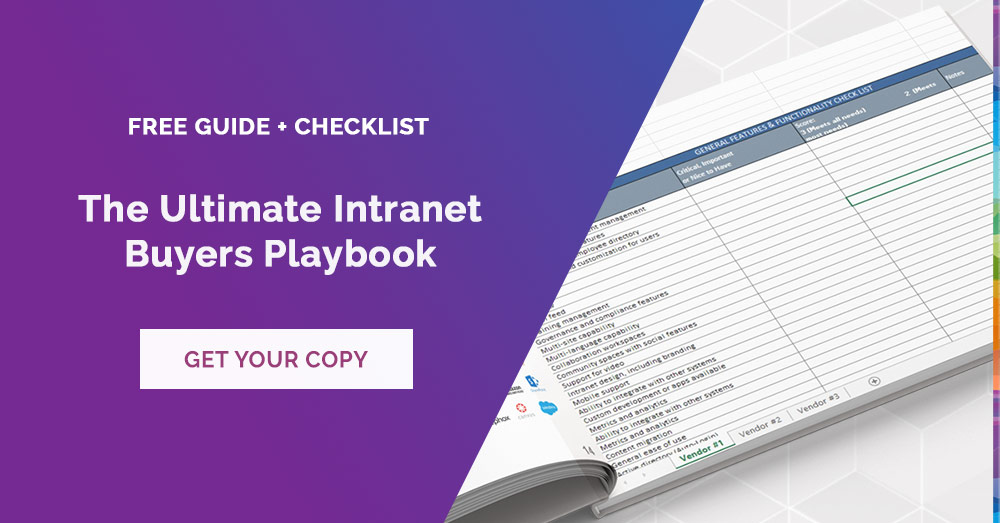There’s a reason everyone seems to be talking about employee engagement these days; it’s the cornerstone to boosted productivity, better employee retention and a workplace culture where people love to work!
A Predictive Index report found that engaged workforces also perform better financially, with one Best Buy store quantifying the annual value of a 0.1% increase in engagement at US$100,000.
So we know that employment engagement is important – but how do we make it happen?
A study by HR.com and Bonusly called The State of Employee Engagement has outlined several key drivers of employee engagement, identified by mostly HR professionals.
A modern intranet, is often the foundation of an employee engagement platform, and the right intranet best practices, can actively support these key drivers. Here, we explore exactly what that might look like.
Trust in Leaders
Above all else, survey respondents said that two vital leadership aspects drove employee engagement. 81% said trust in leaders was crucial, and 79% said that employees’ relationships with their immediate supervisors matter a great deal. It’s easy to see why; strong relationships between c-suite and employees will benefit everyone.
C-suite managers can better understand employees and confidently apply their own unique leadership style. Meanwhile, employees feel respected, valued and heard.
How to support this in an intranet environment that will boost employee experience:
- Maintain consistent communication from leaders
It’s never been so easy for leaders to provide regular touchpoints with their teams, sharing meaningful messaging via intranet blog posts, news, social posts and/or videos.
- Celebrate group and individual achievements
Supervisors can be encouraged to highlight great work from their teams and individual employees, providing positive notifications in the intranet as a way of recognising great work.
- Offer two-way feedback channels
Regular and relaxed feedback between employees and leaders can help to build trust and identify any issues early on. Pulse surveys, forms and polls can all be used to great effect here.
A Sense of Purpose
75% of survey respondents said that having a sense of purpose is a key driver for employee engagement. And central to this is understanding the organisation’s core vision, mission and values.
When these aspects are clearly defined, both new and existing employees are given a direction they can enthusiastically get on board with.
How to support this in an intranet environment that will boost employee experience:
- Provide meaningful work for each employee
70% of highly engaged organisations say they provide employees with meaningful work, versus 40% of less engaged organisations. Personalised intranet dashboards, search and user experiences can be so important so each employee knows their mission for the day and weeks ahead.
- Be clear about goals, visions and values
These will ideally be prominently displayed on your intranet, but also reflected through your wider content strategy, announcements and updates. An organisation that values itself on collaboration should naturally have an intranet where employees can work together with ease, for example.
- Assess your organisational culture over time
Organisational culture was identified as a key driver of employee engagement for 74% of respondents. Aim to understand your changing culture over time especially for your remote workforce using social, business and financial indicators, and measure the results of any communications strategies and initiatives.
Belief in the Organisation
69% of survey respondents said that having belief in the organisation is a driver of employee engagement. Of course, this ties in with having an individual sense of purpose, but when employees believe in the organisation it also means they trust and respect the business they work for.
What makes employees proud to be working where they work?
How to support this in an intranet environment that will boost employee experience:
- Provide a functional, intuitive intranet
You could erode confidence with an intranet that barely works, or build confidence with a seamless daily user experience to support each employee’s role. There are several aspects your intranet needs to be successful. For example, bottom-up customisation allows each employee to tailor their relevant widgets, content and information for ultimate ease of use.
- Use influencers to share messages
Consider who your internal influencers are (Formal leaders? Brett in HR who everyone loves interacting with?) and whether they can help to share messaging around organisational goals and positive company policies.
- Explore connections with the wider world
There are numerous advantages of digital transformation when it comes to fostering relationships and growing networks. Your intranet is the perfect place to share news announcements and updates about how employees and the organisation are connecting with the wider world in a positive way, from volunteer roles to fundraising and charity events.
Opportunities for Career Growth
If employees can’t see room for growth with your organisation, they’ll naturally look elsewhere. 68% of survey respondents said that employees will be engaged if they can see opportunities to make progress in their career.
On the other hand, Glassdoor research has shown that employees who stay longer in their role without a title change are significantly more likely to leave the company. Great talent therefore needs to be nurtured.
How to support this in an intranet environment that will boost employee experience:
- Modernise professional development
Online learning can be provided easily with the right learning management system in Australia, allowing employees to upskill and even retrain for new roles at their own pace.
- Share and hold development events
Your intranet’s Events calendar can provide an invaluable place for employees to seek out fresh new knowledge, whether it’s virtual networking events, physical workshops or guest speaker experiences.
- Recognise those who go above and beyond
Highlighting and encouraging top achievers in your dedicated intranet space can foster those who give their role extra time and energy. You can also encourage quality talent to apply for new roles on your internal job board
Enjoyment of Work
When asked about drivers of employee engagement, 68% of survey respondents said that it was important that people enjoy their work. This can encompass both their role and the perks they experience, whether that be a healthy work-life balance or flexibility in working arrangements.
How to support this in an intranet environment that will boost employee experience:
- Provide support for life-friendly work
Flexible working arrangements have become increasingly important for employees, particularly since the pandemic began. More Australians now want to work from home an average of two days a week, for example. Your intranet? It’s the key to successful, productive remote work.
- Share the social aspects
Your intranet isn’t just for serious work – it can also include social spaces, galleries of company events and social forums. Gamification can make even the dullest processes enjoyable.
- Cut out the clutter
Atlassian research shows that the typical employee checks their email 36 times every hour and spends 16 minutes refocusing after handling an incoming email. A personalised, well-structured intranet with effective search can drastically cut down these irritating (and costly) inconveniences.

Relationships with Colleagues
67% of survey respondents value relationships between colleagues as a key driver of employee engagement. These interpersonal relationships can’t be manufactured – but they can be supported with the right opportunities for connection and collaboration.
How to support this in an intranet environment that will boost employee experience:
- Develop a detailed corporate directory
An organisation’s corporate directory, complete with organisational chart, makes it easy to find the right people fast and clear up any confusion. Encouraging users to fully complete their profile including a headshot and bio information will give a fuller picture for all.
- Foster connection around shared goals and interests
This can take shape in a number of ways, from providing project-based team workspaces to encouraging social discussions around common interests. Virtual happy hour, anyone?
- Encourage collaborative content creation
Encouraging employees to collaborate with colleagues to share ideas through creating wikis and articles has a multitude of benefits. Quality content, shared knowledge, motivated employees and a sense of collaboration in the workplace are just a few of those benefits.
It’s important to understand that high employee engagement doesn’t come from just one of these factors – it can take a combination of these elements and more.
One thing is for sure: the right employee intranet software is essential.
Need help deciding on the right solution for you? Download the Intranet Buyers Playbook complete with a detailed comparison checklist.
